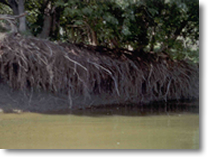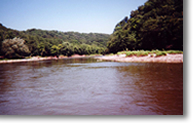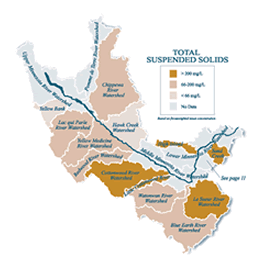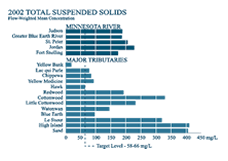| |

|
|
|
The Minnesota River carries more suspended sediment than most of the state’s rivers.The average sediment load in the Minnesota River at Mankato is equal to 2,700 tons per day or a 10-ton dump truck load every five and a half minutes.
Animation courtesy of www.Louswheels.netfirms.com |
|
|
| |
|
What are Total Suspended Solids (TSS)?
Sediment is a natural part of the ecosystem and the transport of sediment is a natural function of rivers. Streams transport sediment washed in from the watershed and deposit it on natural bars or into the larger rivers and lakes that they empty into. Modification of the landscape has accelerated the rate of erosion of soil into waterways. Problems occur when the protective vegetative covering from soils is removed. Loose sediments are then free to wash into the streams with surface water runoff during rain storms. Increased runoff has resulted in stream bank erosion.
Why is TSS important?
Elevated sediment (suspended soil particles) in waterways has many impacts. It makes rivers look muddy (increases turbidity), affecting aesthetics and swimming. Excess sediment degrades the river system, filling reservoirs, destroying aquatic habitats, altering biotic communities, increasing water treatment costs and reducing the river’s aesthetic qualities.
Additonally, sediment carries nutrients, pesticides, and other chemicals into the river that may impact fish and wildlife species. Sedimentation can restrict the areas where fish spawn, limit biological diversity, and keep river water cloudy, reducing the potential for growth of beneficial plant species. Find out more about where the sediment comes from.
|
|

|
What is the standard for TSS?
Minnesota does not currently have a water quality standard for total suspended solids (TSS) but does have a turbidity standard of 25 nephelometric turbidity units (NTUs). NTUs are the units used to measure turbidity. The term Nephelometric refers to the way the instrument estimates how light is scattered by suspended particulate material in the water. Learn more about turbidity on water on the web.
Minnesota Pollution Control Agency studies have shown a strong relationship between TSS and turbidty and can use TSS for a surrogate to assess water quality conditions required by the Clean Water Act. In the Western Corn Belt Plains and Northern Glaciated Plains ecoregions, which encompass the majority of the Basin, surrogate TSS thresholds of 58 and 66 milligrams per liter (mg/L), respectively, can now be used too assess waters when sufficient turbidity data are lacking.
What is the status of TSS in the Minnesota River Basin?
Although sediment is a part of the natural environment, human activities sometimes increase the amount that ends up in our streams. Total suspended solids are a major water quality concern in the Minnesota River. Soils in the Basin have a high silt and clay content. Eighty-six percent of the suspended sediment in the Basin is characterized by fine particles of silt and clay that are easily transported in water.
The Minnesota River carries more suspended sediment than most of the state’s rivers. The United States Geological Survey measured sediment in the river at Mankato for 13 years and found a median concentration of 92 milligrams per liter, a load equal to 2,700 tons per day or a 10-ton dump truck load every five and a half minutes (Basin Information Document).
|
|
| Blue Earth River sediment laden water with roots exposed by erosion. |
|
|
 |
|
| Blue Earth River |
|
|
| |
|
|
|
The map and chart at right illustrates the Total Suspended Solids levels in 2002 for selected Minnesota River Basin watersheds. The illustrations show flow-weighted mean concentrations of TSS. This is equivalent to routing all of the flow that passed a monitoring site during a specific timeframe into a big, well-mixed pool, and collecting and analyzing one sample from the pool to give the average concentration.
For the major tributaries, substantial differences in TSS flow-weighted mean concentrations are apparent across the Minnesota River Basin with concentrations seldom exceeding 100 mg/L in major tributaries in the upper part of the Basin. In contrast, concentrations in major tributaries in the lower part of the Basin frequently are much greater than 100 mg/L.
Learn more about turbidity
|
 |
|
| |

|
|
|
References:
State of the Minnesota River: 2002 Surface Water Quality Monitoring.
Minnesota River: Basin Information Document. Minnesota Pollution Control Agency. November, 1997.
Duluth Streams website - http://www.duluthstreams.org/
MPCA Glossary website - http://www.pca.state.mn.us/gloss/index.shtml
MPCA Ecoregion website - http://www.pca.state.mn.us/data/eda/wqguide.html
Water on the Web website - http://waterontheweb.org/under/waterquality/
|
Back to pollutants
For more information about TSS in the Minnesota River Basin, see publications. |
|
|
| |
|
|
|
|
|
|





